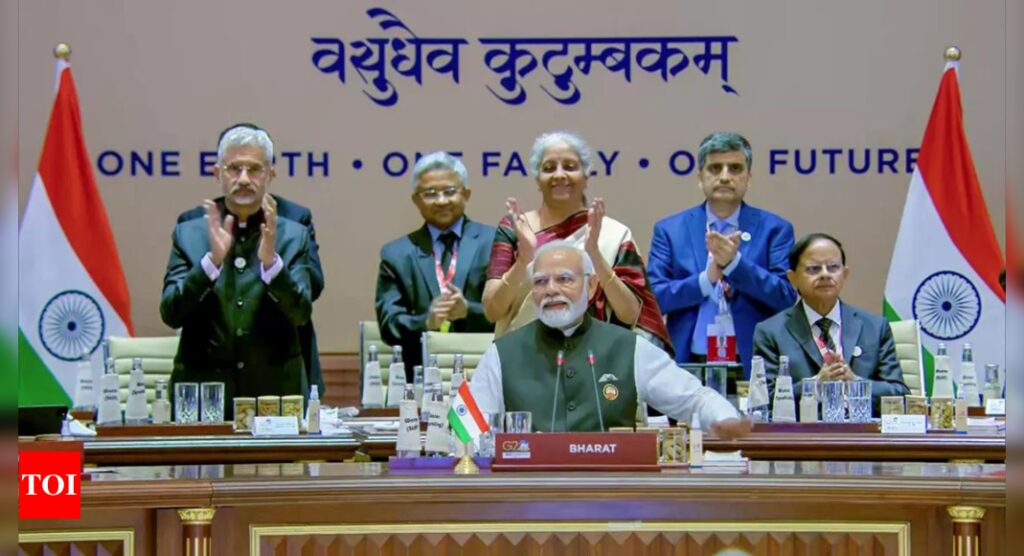[ad_1]
MUMBAI: A day after the G20 summit’s Delhi Declaration, which highlighted the importance of advancing nuclear technology and the design and development of small modular reactors (SMRs), atomic energy officials revealed Sunday the country’s dedicated efforts in “these new types of reactors”.
The declaration underscores that “countries that opt to use civil nuclear energy will collaborate on voluntary and mutually agreed terms, in research, innovation, development, and deployment of civil nuclear technologies, including small modular reactors, in accordance with national legislation”.
Speaking on the condition of anonymity, officials said the country is earnestly engaged in the development of these novel reactors. The atomic energy department is currently exploring various designs and concepts for these SMRs, with a finalised plan expected to materialise soon, provided everything proceeds as planned.
The department of atomic energy, Bhabha Atomic Research Centre (BARC), and Niti Aayog jointly prepared a report in May this year — titled “A Report On The Role of Small Modular Reactors In The Energy Transition — featuring the G20 logo. The report states that one notable advantage of SMRs is their smaller footprint compared to large reactors.
SMRs, with a capacity ranging from less than 30 MW to about 300 MW, offer potential deployment advantages such as reduced emergency planning zone size and passive safety systems. Most SMRs can be refuelled every three to seven years, with some potentially extending to 30 years, contrasting with the annual refuelling required for most large reactors.
The report outlines that these reactors are “conceptualised in such a way that their systems, structures and components are manufactured in a factory and transported to the project site”.
Several countries have already initiated steps toward the early deployment of SMRs, according to the report. The International Atomic Energy Agency (IAEA) projects a significant increase in global nuclear installed power capacity, estimating a rise from 413 GW to 871 GW by 2050.
KN Vyas, former chairman of Atomic Energy Commission, expressed optimism in the report, saying: “Small modular reactors with robust passive safety features may pick up momentum to achieve sustainable growth of the nuclear industry.” In the same report, current chairman Ajit Kumar Mohanty underscores the importance of these innovative new reactors in the energy landscape.
The declaration underscores that “countries that opt to use civil nuclear energy will collaborate on voluntary and mutually agreed terms, in research, innovation, development, and deployment of civil nuclear technologies, including small modular reactors, in accordance with national legislation”.
Speaking on the condition of anonymity, officials said the country is earnestly engaged in the development of these novel reactors. The atomic energy department is currently exploring various designs and concepts for these SMRs, with a finalised plan expected to materialise soon, provided everything proceeds as planned.
The department of atomic energy, Bhabha Atomic Research Centre (BARC), and Niti Aayog jointly prepared a report in May this year — titled “A Report On The Role of Small Modular Reactors In The Energy Transition — featuring the G20 logo. The report states that one notable advantage of SMRs is their smaller footprint compared to large reactors.
SMRs, with a capacity ranging from less than 30 MW to about 300 MW, offer potential deployment advantages such as reduced emergency planning zone size and passive safety systems. Most SMRs can be refuelled every three to seven years, with some potentially extending to 30 years, contrasting with the annual refuelling required for most large reactors.
The report outlines that these reactors are “conceptualised in such a way that their systems, structures and components are manufactured in a factory and transported to the project site”.
Several countries have already initiated steps toward the early deployment of SMRs, according to the report. The International Atomic Energy Agency (IAEA) projects a significant increase in global nuclear installed power capacity, estimating a rise from 413 GW to 871 GW by 2050.
KN Vyas, former chairman of Atomic Energy Commission, expressed optimism in the report, saying: “Small modular reactors with robust passive safety features may pick up momentum to achieve sustainable growth of the nuclear industry.” In the same report, current chairman Ajit Kumar Mohanty underscores the importance of these innovative new reactors in the energy landscape.
[ad_2]
Source link











More Stories
Congress replaces Kamal Nath, names an OBC as Madhya Pradesh chief | India News
Fire breaks out in ITBP camp in Srinagar; none hurt | India News
Parliament Security: Co-villagers give clean chit to Lalit Jha, parents to move court | India News